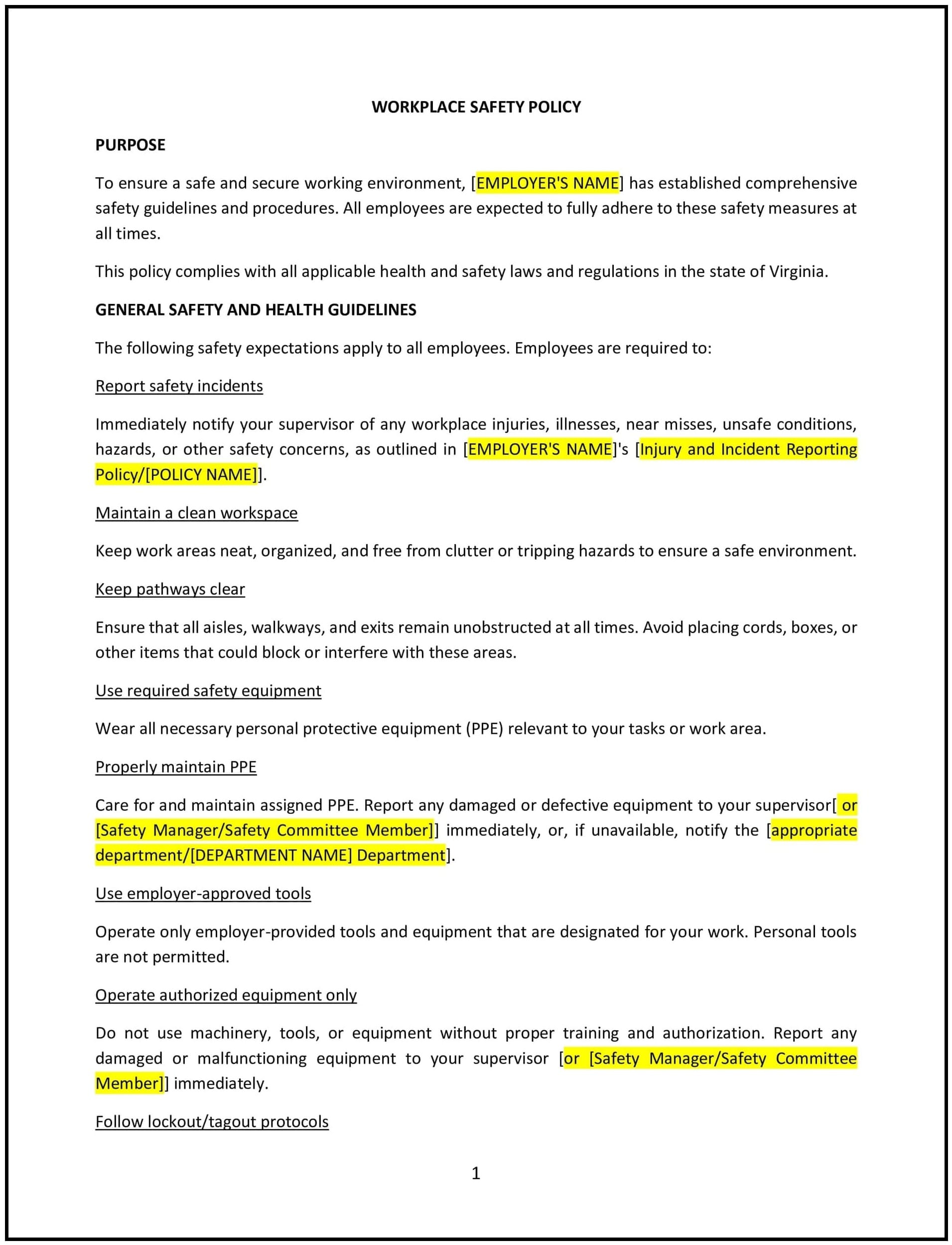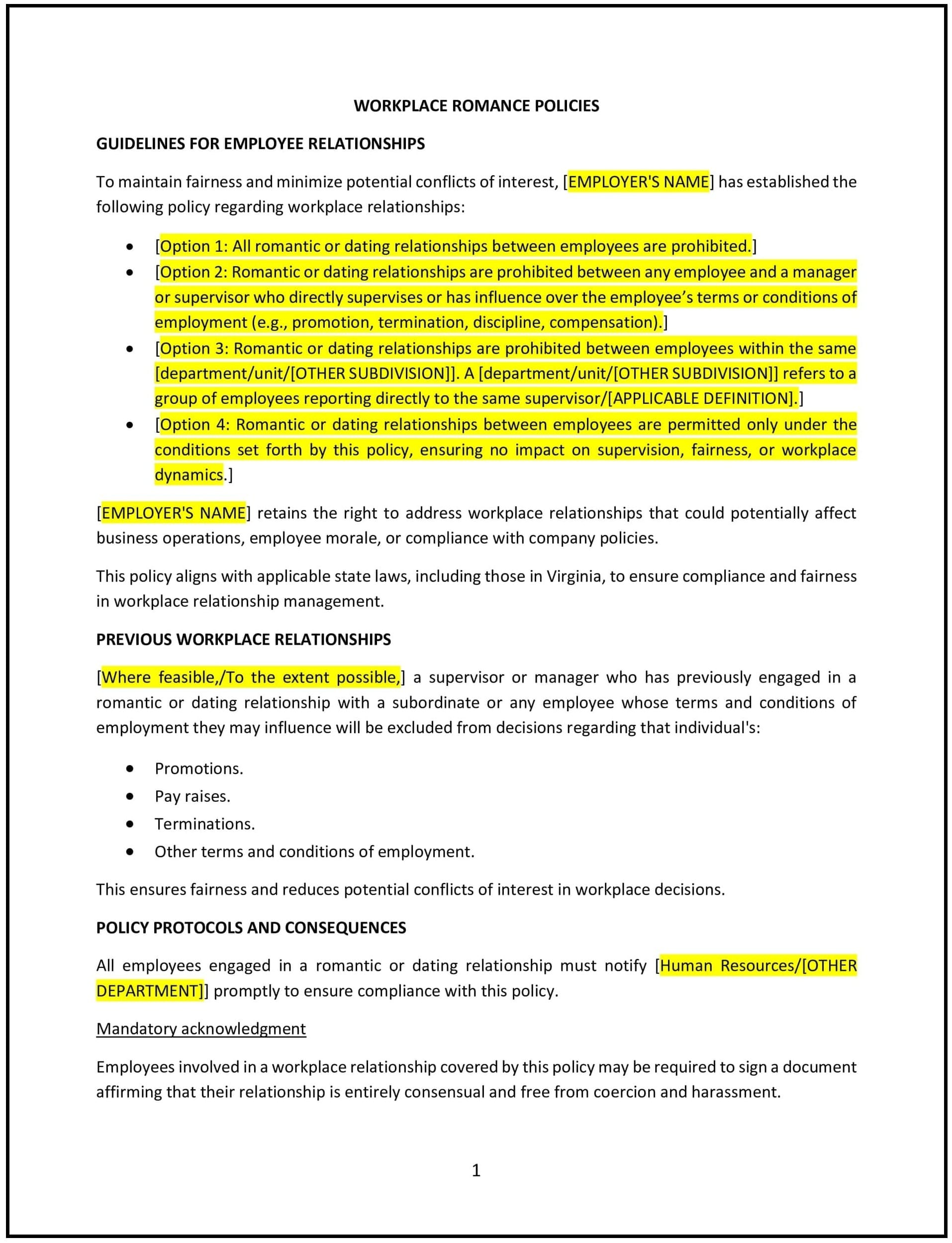Workplace safety policy (Ohio): Free template

Workplace safety policy (Ohio)
A workplace safety policy outlines the guidelines and procedures for ensuring the safety and health of employees in Ohio. This policy aims to prevent accidents, injuries, and health hazards by establishing clear safety protocols, providing necessary training, and ensuring compliance with state and federal regulations. It sets expectations for safe practices, the use of protective equipment, emergency procedures, and the reporting of safety concerns. The policy also defines the responsibilities of both employees and management in creating and maintaining a safe work environment.
By implementing this policy, Ohio businesses can reduce the risk of workplace accidents, protect employee well-being, and demonstrate a commitment to safety that benefits both the workforce and the business’s operations.
How to use this workplace safety policy (Ohio)
- Define safety responsibilities: The policy should clearly outline the roles and responsibilities of employees, supervisors, and management in ensuring workplace safety. This includes reporting hazards, adhering to safety protocols, and attending safety training sessions.
- Set safety training requirements: The policy should specify the type of safety training employees are required to complete, such as general safety, emergency response, equipment handling, and specific job-related safety training. It should define when training will take place (e.g., during onboarding, annually, or after specific incidents).
- Outline safety equipment requirements: The policy should detail the safety equipment employees are required to use, such as helmets, gloves, safety glasses, or ear protection. It should specify when and where the use of personal protective equipment (PPE) is mandatory.
- Establish procedures for reporting hazards: The policy should define how employees should report safety hazards or unsafe conditions, including the channels for reporting and the process for addressing those concerns. Employees should feel encouraged to report any hazards without fear of retaliation.
- Define emergency procedures: The policy should outline the procedures to follow in case of an emergency, such as fire drills, evacuations, medical emergencies, or chemical spills. It should specify emergency contacts, exit routes, and any equipment (e.g., first aid kits, fire extinguishers) employees need to be familiar with.
- Set expectations for safety audits and inspections: The policy should include guidelines for regular safety audits, inspections, and risk assessments. It should outline the frequency of these checks and who is responsible for conducting them to ensure the workplace remains free from hazards.
- Include protocols for workplace injuries: The policy should provide clear steps for handling workplace injuries, including immediate first aid, reporting the injury, and seeking medical attention. It should also specify whether employees are eligible for workers' compensation and the process for filing a claim.
- Review and update regularly: The policy should be reviewed periodically to ensure it remains effective, complies with Ohio state laws, and aligns with industry best practices. It should also be updated as necessary to address emerging risks or changes in the workplace environment.
Benefits of using this workplace safety policy (Ohio)
This policy provides several key benefits for Ohio businesses:
- Reduces workplace accidents: By establishing clear safety protocols, the policy helps reduce the likelihood of accidents, injuries, or health-related incidents, promoting a safer working environment.
- Enhances employee well-being: A focus on safety protects employees’ physical and mental health, creating a work environment where they feel secure and supported.
- Ensures legal compliance: The policy helps businesses comply with Ohio state laws, Occupational Safety and Health Administration (OSHA) regulations, and other safety standards, minimizing the risk of legal issues or fines.
- Boosts productivity: Employees are more likely to be productive when they feel safe at work. A safe environment fosters confidence, reduces distractions, and prevents downtime caused by accidents.
- Improves employee morale: When businesses demonstrate a commitment to safety, employees feel valued and respected. This can improve job satisfaction, retention, and overall workplace culture.
- Minimizes liability: By proactively addressing safety concerns and following established safety procedures, businesses reduce the risk of liability associated with workplace accidents or injuries.
- Strengthens reputation: A solid commitment to workplace safety enhances the business’s reputation as a responsible and ethical employer, making it more attractive to prospective employees and clients.
Tips for using this workplace safety policy (Ohio)
- Communicate the policy clearly: Ensure that all employees are familiar with the workplace safety policy by including it in the employee handbook, discussing it during onboarding, and conducting regular safety briefings and refresher courses.
- Provide ongoing safety training: Safety training should not be a one-time event. Offer regular training sessions to keep employees updated on new safety procedures, tools, or changes to workplace conditions.
- Foster a safety culture: Encourage employees to take an active role in promoting workplace safety by reporting hazards, suggesting improvements, and participating in safety committees or initiatives.
- Track safety performance: Regularly assess the effectiveness of safety measures by tracking workplace injuries, near-misses, and safety audits. Use this data to identify patterns and address areas for improvement.
- Empower employees: Give employees the tools and authority to stop unsafe work practices. Make it clear that no task is worth compromising safety, and employees should feel comfortable intervening if they observe unsafe behavior.
- Review the policy periodically: The safety policy should be reviewed at least annually to ensure it aligns with Ohio state laws, federal regulations, and any changes in the business’s operations or industry standards. Adjustments should be made as needed to ensure continued safety.
- Promote accountability: Hold employees and management accountable for upholding safety standards. Ensure that any violations of the policy are addressed promptly and that corrective actions are taken when necessary.
Q: What should employees do if they identify a safety hazard?
A: Employees should report any safety hazards immediately to their supervisor, HR, or safety representative, depending on the business’s procedures. The policy should specify how employees can report concerns, whether through an online system, directly to management, or anonymously.
Q: Are safety inspections required?
A: Yes, the policy should specify that safety inspections will be conducted regularly to identify potential hazards and ensure that safety measures are being followed. These inspections may be performed by safety officers or management and should be documented for record-keeping purposes.
Q: What happens if an employee is injured at work?
A: The policy should outline the steps an employee should take if they are injured at work, including notifying their supervisor, seeking medical attention, and completing any required documentation. The policy should also detail the process for filing a workers' compensation claim if applicable.
Q: Does the workplace safety policy apply to all employees?
A: Yes, the workplace safety policy applies to all employees, regardless of position or department. It is designed to ensure that every individual working in the business is protected and follows the same safety guidelines.
Q: Can employees be disciplined for not following safety procedures?
A: Yes, the policy should clarify that employees who fail to follow safety procedures may face disciplinary action, including retraining, suspension, or termination, depending on the severity of the violation.
Q: How can businesses create a safety culture?
A: Businesses can create a safety culture by involving employees in safety initiatives, encouraging open communication about safety concerns, offering regular training, and recognizing employees who demonstrate a commitment to workplace safety.
Q: How should employees report workplace injuries or near-misses?
A: Employees should report workplace injuries or near-misses to their supervisor or HR as soon as possible. The policy should specify the process for reporting, including any forms or documentation that need to be completed.
Q: How often should the workplace safety policy be reviewed?
A: The policy should be reviewed annually or whenever there are changes to Ohio state laws, federal regulations, or the business’s operational practices. Regular reviews help ensure the policy remains effective and up-to-date with the latest safety standards.
This article contains general legal information and does not contain legal advice. Cobrief is not a law firm or a substitute for an attorney or law firm. The law is complex and changes often. For legal advice, please ask a lawyer.


